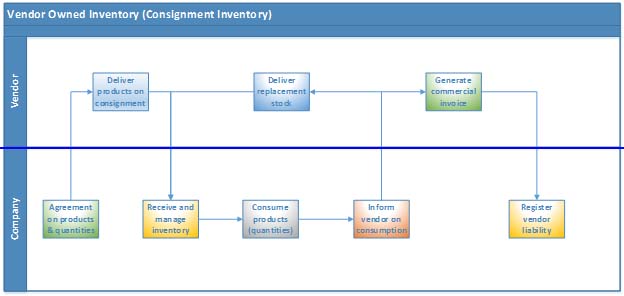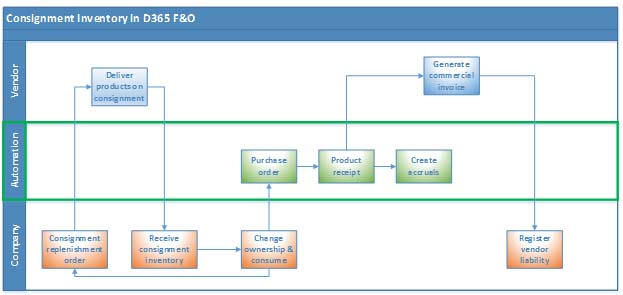Consignment Inventory or Vendor-owned Inventory
Consignment inventory is an element of supply chain management in which the vendor inventory is held at the customer warehouse. The customer doesn’t pay for the goods until the goods are consumed, and in most cases, pays only the amount consumed.
When receiving the inventory, the physical receipts and on-hand inventory transactions are posted in the system, without any general ledger postings.
At the time of actual consumption, the ownership changes and the financial (GL) transactions are posted.
The vendor can monitor the consumption of inventory at the customer site (usually through a Vendor Portal or system integration or EDI).
This concept has a lot of advantages for both customer and vendor and continues to gain popularity in recent years.
- Beneficial for long-term business between supplier and the consumer.
- Reduced transportation and inventory costs.
- Higher quality assurance as goods typically come from a focused production run and manufactured date
- Less risk in the form of purchasing and management approvals.
- Better cash flow for the consumer.
- Fewer variables in production planning.
- Reduced turnaround time leading to better end-customer experience.
- Supplier retains full ownership and visibility.
- More predictable demand forecasting and replenishment planning.
- Supplier gets to push any new products through its supply chain while still testing the demand. At the same time, the consumer (retailer) will be able to launch new product lines with minimal risk.
As with anything, consignment does have some downsides. From the customers, there are risks associated with damaged inventory and stock counting errors. The disadvantages to suppliers are cash flow uncertainty and cost of unsold inventory. For non-durables, there are additional factors to be considered.
How To Make Consignment Inventory Work For Everyone
Cultivate mutually beneficial relationships
Suppliers and consumers can reap the biggest rewards from Consignment Inventory by developing an honest partnership, working together to improve their processes, sharing inventory details and strengthen their supply chain management.
Both parties can benefit immensely by using a good inventory management software that automates the processing of consignment orders based on current inventory levels and keeps all parties informed.

Create a mutually beneficial contract
Outline the responsibilities and expectations of each party in detail, the length of time the inventory is held, the prices of the goods, liability in the event of damage, etc. The detailed/thorough contract helps transparency in your business partnership and helps mitigate possible disputes in future.
Use an Inventory Management Software with Consignment Inventory feature
An optimal solution would be to invest in an inventory management software that is designed to handle consignment inventory.
The software should track the goods shipped & ordered, utilization and replenishment levels, and additional information regarding the inventory in both physical and financial terms.
The information should be transparent, and the information flow automated.

The brief overviews below are real world application of this concept, and we will keep this discussion at a conceptual level to maintain client confidentiality.
Scenario A:
Due to the freight costs associated with moving large industrial equipment parts and the tremendous benefits of co-marketing, we helped one of our clients through this process of Consignment Inventory for a select few of their suppliers/vendors, also referred as Partners (as they truly are).
This process helped maintain a smooth production flow, meet the end-customer demand effectively and reduced freight costs. Being a 100-year company with strong trusted relationships with its business partners, made the execution go smooth.
Scenario B:
In the steel and metal fabrication industry the trucking costs and material handling costs directly have an impact the company’s tight profit margin.
To be globally competitive, this concept is taking root. Few companies have implemented inventory management software systems to build that ecosystem with their business partners both on the supply side as well as on the demand side. EDI-enablement makes the workflow highly automated, information flow instantaneous and decision process based on real-time data.
When executing this concept, this metal processing company took a step by step approach. Certain products were ear-marked on specific production lines and those specific raw materials (goods) could be stored by the vendors in the warehouse. Vendors were informed in advance on the warehouse capacity. Suppliers have configured their inventory systems accordingly to make their plans, safety stock levels for the smooth production runs. Company and the suppliers were excited to partake in helping execute such a process and take the trust to a new level.
Vendors were notified of the consumption which initiated two activities at the vendor’s side. The first is to issue an invoice for the material consumed and the second is to replace the consumed stock when the levels go below threshold. Additionally, suppliers got an insight on consumption in order to do their own Production and Material Planning.
A consignment replenishment order is a document that is used to request and keep track of inventory quantities of products that a vendor intends to deliver within a certain date interval by creating ordered inventory transactions.
Typically, this will be based on the forecast and actual demand of the specific products. The inventory that’s going to be received against the consignment replenishment order remains in the ownership of the vendor.
This topic includes information about how to physically receive vendor-owned inventory on-hand without creating general ledger transactions, how to start a production process where the vendor-owned inventory can be physically reserved. and how to change the ownership of the raw material in order to be able to process the consumption as part of the production order processing. There’s also some information about how vendors can monitor consumption of their inventory using the vendor collaboration interface.

The Dynamics 365 Supply Chain:
It is always delighting to the company when a major ERP solution like Microsoft Dynamics has got it right and most of the requirements were part of the standard feature set.
The consignment (replenishment) order effectively manages vendor owned inventory by marking the ownership of the received inventory to the vendor. Such receipts of inventory are updated only in the inventory register without any financial (GL) effect. The best part of consignment inventory is that the on-hand quantities are available for reservation and other planning processes. Of course, before consumption of vendor-owned inventories, the ownership should be changed to the company.
The process of changing the ownership releases a purchase order to the vendor for the quantities the ownership is changed with product receipt status updated. This automatic process cuts short the repetitive process of creating a purchase order and posting the product receipt. Moreover, this automatic process takes care of the financial (GL) transactions, if any, associated to the product receipt (accruals).
On receiving the information about the purchase order and the product receipt, vendor can now issue the invoice. In parallel, the company issues the consignment replenishment order to replace the stocks that are consumed for the period, which triggers the next cycle of consignment inventory.

The vendor collaboration interface provides more meat to the automation process in the form of instant communication, on-hand consignment inventory status, and posted product receipt details.


